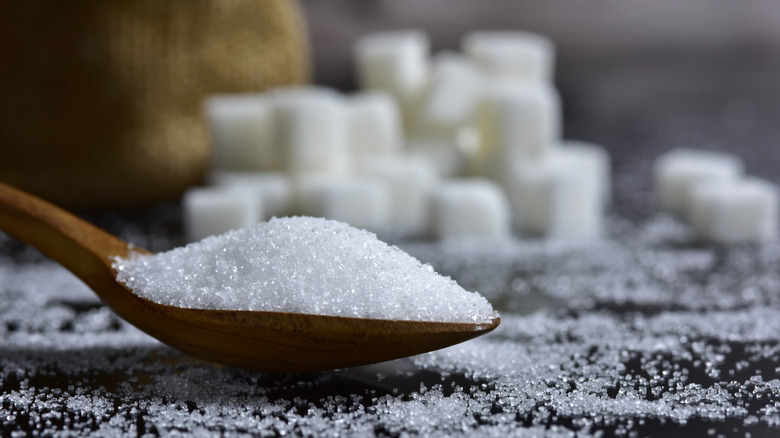How To Stop Wasting Your Money On Colorful Sanding Sugar
Colorful sanding sugar has many decorative uses in the kitchen. However, it's also much more expensive than granulated sugar. Cooks on a budget can create their own sanding sugar for cookies, cakes, and pastries. Keep in mind, it will take some time because granulated sugar differs greatly from its more decorative cousin. But if you have some free time to spare, the extra effort can definitely save you some money (and save you from those dreaded sprinkles).
Sanding sugar is more coarse, meaning the granules of sugar are bigger. The larger crystals don't dissolve when they come in contact with heat or liquids, making them ideal for use on cookies with wet icing, for example. When the icing hardens and the pastries cool, the sanding sugar still shines like it's glitter-infused. Granulated sugar can't do that on its own. But with a little work, you can create your own sanding sugar from the granulated variety that's much easier on your budget.
Making your own colorful sanding sugar is cheap and easy
Making your own sanding sugar isn't about changing granulated sugar into sanding sugar and then adding color. Instead, this process will make the granulated sugar shinier and more resistant to heat and water. Start with granulated sugar and food coloring (liquid or gel). If you're making white sanding sugar, then all you need to use is water.
Put the sugar in a sealable plastic bag, then add a drop or so of food coloring (something the youth seem quite fond of). Make multiple bags for multiple colors. Seal the bag and massage the food color into the sugar until it's on all of the sugar in the bag. Don't worry about clumps just yet. Prepare a baking sheet with foil or a silicone mat. Now pour the sugar onto the sheet but don't make the layer too thin and don't mix colors — use separate baking sheets for different colors. The sugar will melt and possibly burn if layered too thinly, so keep that in mind.
Put the sheet into an oven preheated to 250 degrees Fahrenheit. Bake until the sugar looks dry and shiny. Take the baking sheet out of the oven and let it cool. Then, gently sift the sugar to remove clumps. Don't use the food processor because it will grind the sugar back down, reversing the process that you just went through. Store the sugar in an airtight container and use it as needed. If you don't want to use the oven, you can always just let it air dry.

